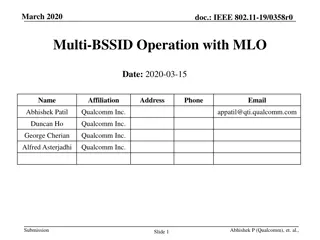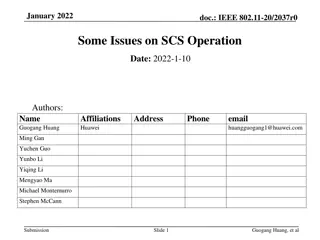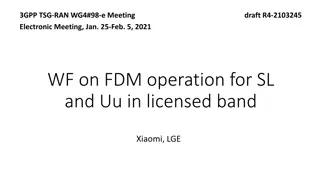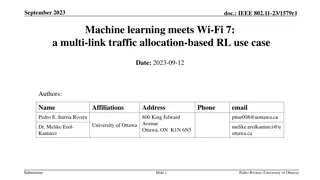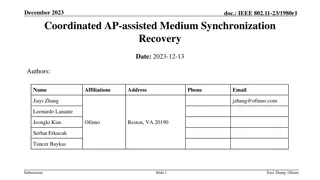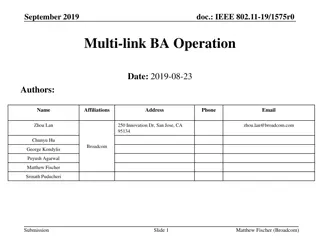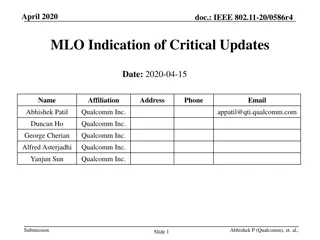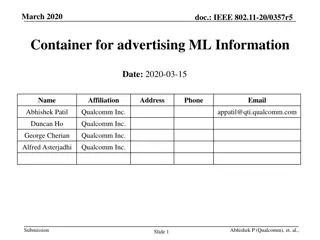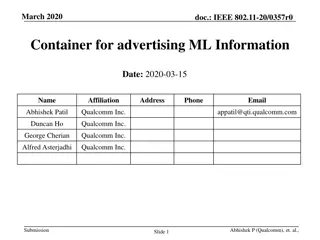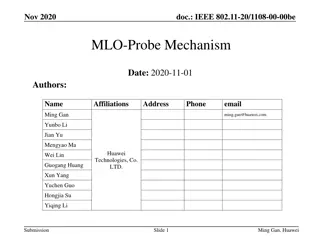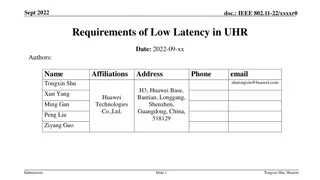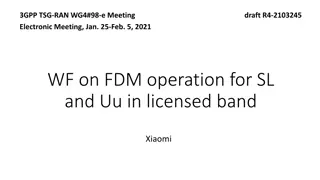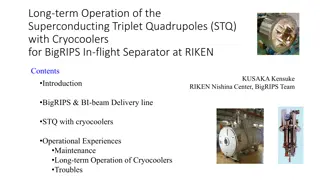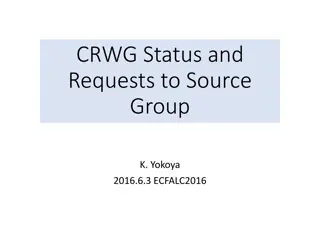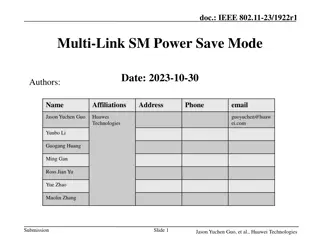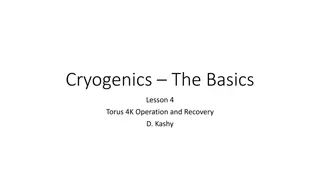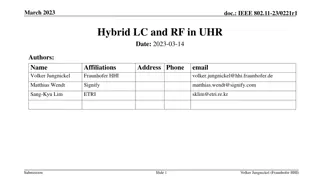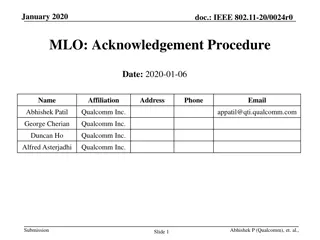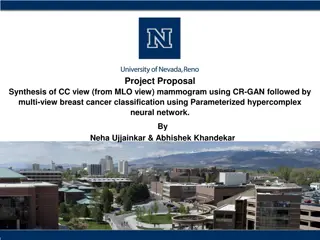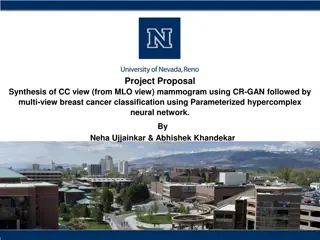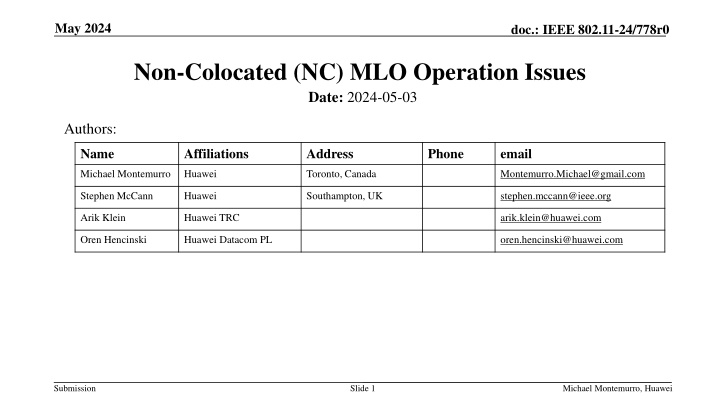
IEEE 802.11-24/778r0 Non-Colocated MLO Operation Issues
Explore the challenges and use cases of Non-Colocated Multi-Link Operation (NC-MLO) in IEEE 802.11-24/778r0 document. Learn about BA operation, high reliability services, and the architecture for multi-link data paths. Discover how NC-MLO enables roaming, reliability, and relay operations, offering insights into the future of wireless networking.
Download Presentation

Please find below an Image/Link to download the presentation.
The content on the website is provided AS IS for your information and personal use only. It may not be sold, licensed, or shared on other websites without obtaining consent from the author. If you encounter any issues during the download, it is possible that the publisher has removed the file from their server.
You are allowed to download the files provided on this website for personal or commercial use, subject to the condition that they are used lawfully. All files are the property of their respective owners.
The content on the website is provided AS IS for your information and personal use only. It may not be sold, licensed, or shared on other websites without obtaining consent from the author.
E N D
Presentation Transcript
May 2024 doc.: IEEE 802.11-24/778r0 Non-Colocated (NC) MLO Operation Issues Date: 2024-05-03 Authors: Name Affiliations Address Phone email Michael Montemurro Huawei Toronto, Canada Montemurro.Michael@gmail.com Stephen McCann Huawei Southampton, UK stephen.mccann@ieee.org Arik Klein Huawei TRC arik.klein@huawei.com Oren Hencinski Huawei Datacom PL oren.hencinski@huawei.com Submission Slide 1 Michael Montemurro, Huawei
May 2024 doc.: IEEE 802.11-24/778r0 Scope 802.11be introduced Multi Link Operation (MLO) Although it is not explicitly stated, the 11be ML architecture does not enable non-colocated ML operation (NC-MLO) This document discusses issues associated with NC-MLO in three areas: BA Operation Using links simultaneously to achieve high reliability and high throughput NC-MLO modes and challenges NC-MLO opens the door to supporting a variant of high reliability use cases such as: multi-link roaming, relay etc. Submission Slide 2 Michael Montemurro, Huawei
May 2024 doc.: IEEE 802.11-24/778r0 NC-MLO Use Cases Recap Roaming keeping highly reliable (low latency , reliability of 10-5 packet loss) data transmission while being connected to the current AP on one link and to the target AP on the second link [1][2][3][4][5] (Huawei, Intel, Cisco, etc.) High Reliability Service at overlapping area between cells [6] (MediaTek) Relay Operation [7] Relayed STA connectivity to both MLD Home Gateway and Relay MLD AP (Huawei) Submission Slide 3 Michael Montemurro, Huawei
May 2024 doc.: IEEE 802.11-24/778r0 11be Multi Link Data Path Architecture 11be defines that all links are operating under the same Block ACK Agreement (per TID), deriving from that : All links are using the same running sequence number (SN) space per <MLD, TID> All links must merge their BA scoreboard in real time for both Tx and Rx Although 11be doesn t explicitly define the ML as co-located, the current architecture forces it to be co-located Co-located MLO is a limitation for many UHR applications Submission Slide 4 Michael Montemurro, Huawei
May 2024 doc.: IEEE 802.11-24/778r0 11bn Multi Link Data Reliability Recently there have been many presentations on architecture for NC-MLO In this presentation we would like to provide an in-depth look into challenges associated with NC- MLO, focusing on the data path One of the mechanisms to provide reliable communication is to look at using both affiliated STAs simultaneously to transmit traffic. One of the first tasks is to examine NC-MLO and reveal fundamental issues that need to be addressed. Non-802.11 DS SAP + DSAF Interface between UHR AP MLD UMAC and UHR AP MLD LMAC Portal Data from/to UHR non-AP MLD UHR AP MLD UMAC Data from/to EHT non-AP MLD Data from/to EHT non-AP MLD Wired or wireless backhaul connection EHT AP MLD UMAC EHT AP MLD UMAC TID-to-link Mapping /Link Merging TID-to-link Mapping Link Merging ... UHR Collocated AP MLD 1 UHR Collocated AP MLD M ... ... LMAC LMAC LMAC LMAC ... PHY of affiliated AP 0 PHY of affiliated AP N ... PHY of affiliated AP 0 PHY of affiliated AP N Link 0 Link N Link 0 Link N Submission Slide 5 Michael Montemurro, Huawei
May 2024 doc.: IEEE 802.11-24/778r0 BA OPERATION WITH NC MLO Submission Slide 6 Michael Montemurro, Huawei
May 2024 doc.: IEEE 802.11-24/778r0 Block ACK operation with EHT MLO The following slides provide an example to illustrate BA operation with EHT MLO Highlighted entries in the following slides indicate that a communication delay can occur between affiliated AP and AP MLD The example assumes transmission window of 5 frames which must apply to both encryption, transmission, score-boarding, and re-ordering Submission Slide 7 Michael Montemurro, Huawei
May 2024 doc.: IEEE 802.11-24/778r0 Block Ack Example - EHT MLO (1) AP MLD SN=7 SN=8 SN=9 SN=10 1 SN=6 MLD Scoreboard Context NOTE: Highlighted items indicate potential to incur communication delays when affiliated STA and MLD are not co-located. SN=1 SN=2 SN=3 SN=4 SN=5 WinSizeO = 5 2 Affiliated AP1 2.4GHz Affiliated AP2 5GHz 4 1. An AP MLD has 2 links and 10 packets with SNs 1 10 Packets 1 5 are distributed from the AP MLD to the affiliated AP1 (BA window size = 5) Packets 6 - 10 wait. Affiliated AP transmits packets 1-5 Affiliated AP receives BA indicating that 3 was not received by affiliated STA1 Scoreboard in affiliated AP1 is updated to indicate reception of packets 1,2,4,5. Scoreboard is passed up to the AP MLD. (1,2,4,5) Note: this needs to be done for each BA LINK 1 LINK 2 2. 3. Affiliated STA1 2.4GHz Affiliated STA2 5GHz 4. 3 Scoreboard Context SN=1 SN=2 SN=3 SN=4 SN=5 Non-AP MLD Submission Slide 8 Michael Montemurro, Huawei
May 2024 doc.: IEEE 802.11-24/778r0 AP MLD 1 Block Ack example - EHT MLO (2) SN=10 MLD Scoreboard Context SN=6 SN=7 SN=8 SN=9 SN=3 WinSizeO = 5 2 1. MLD re-transmits 3 using affiliated AP1. MLD encrypts packet 6, 7, 8, 9 MLD queues (3 retried, 6,7,8,9) on AP1 AP updates window to (3,6,7,8,9) AP1 transmits (3,6,7,8,9) to affiliated STA 1 Affiliated AP receives BA indicating that (3,6,7,8,9) have been successfully received. Scoreboard in affiliated AP1 is updated to indicate reception of packet 3,6,7,8,9 Scoreboard is passed up to the AP MLD. Affiliated AP1 2.4GHz Affiliated AP2 5GHz 4 2. LINK 1 LINK 2 3. 4. Affiliated STA1 2.4GHz Affiliated STA2 5GHz 3 Scoreboard Context SN=3 SN=6 SN=7 SN=8 SN=9 Non-AP MLD Submission Slide 9 Michael Montemurro, Huawei
May 2024 doc.: IEEE 802.11-24/778r0 AP MLD 1 Block Ack example - EHT MLO (3) MLD Scoreboard Context SN=10 1. AP MLD encrypts 10 and queues the frame on AP1. AP1 transmits (10) to affiliated STA 1 Affiliated AP receives BA indicating that (10) has been successfully received. Scoreboard in affiliated AP1 is updated to indicate reception of packet 10 Scoreboard is passed up to the AP MLD. WinSizeO = 5 2 4 Affiliated AP1 2.4GHz Affiliated AP2 5GHz 2. 3. LINK 1 LINK 2 4. Affiliated STA1 2.4GHz Affiliated STA2 5GHz 3 Scoreboard Context SN=10 Non-AP MLD Submission Slide 10 Michael Montemurro, Huawei
May 2024 doc.: IEEE 802.11-24/778r0 Conclusions on MLO Block ACK operation MLO BA operation requires significant interaction between the MLD upper MAC and the affiliated STA lower MAC (on each acknowledgement). This will limit the ability to provide non-colocated operation since the latency between lower MAC and upper MAC will be increased. The ability to use both links simultaneously is limited (for high reliability scenarios, for example) because of the tight coupling between affiliated STA lower MAC and MLD upper MAC as part of BA operation. Submission Slide 11 Michael Montemurro, Huawei
May 2024 doc.: IEEE 802.11-24/778r0 SIMULTANEOUS LINKS FOR HIGH RELIABILITY AND HIGH THROUGHPUT Submission Slide 12 Michael Montemurro, Huawei
May 2024 doc.: IEEE 802.11-24/778r0 NC MLO to achieve High Throughput Non-802.11 DS SAP + DSAF 6 Interface between UHR AP MLD UMAC and UHR AP MLD LMAC Portal 5 NC-MLD-Global SN In order to achieve high throughput while using NC MLO, the data is split between non co-located links (i.e. non co-located affiliated APs) and then aggregated on the non-AP MLD receiver Working in clean environment (w/o OBSS) using links simultaneously would double the throughput in a similar manner to co-located MLO 4 Data from/to UHR non-AP MLD NC-MLD-Global SN UHR AP MLD UMAC 3 Data from/to EHT non-AP MLD Data from/to EHT non-AP MLD 2 Wired or wireless backhaul connection 1 EHT AP MLD UMAC EHT AP MLD UMAC TID-to-link Mapping /Link Merging TID-to-link Mapping Link Merging ... UHR Collocated AP MLD 1 UHR Collocated AP MLD M ... ... LMAC LMAC LMAC LMAC ... PHY of affiliated AP 0 PHY of affiliated AP N ... PHY of affiliated AP 0 PHY of affiliated AP N Link 0 Link N Link 0 Link N MLD-Rx 2 MLD-Rx 1 Wi-Fi Reordering SN1 Wi-Fi Reordering SN2 3 2 1 NC-MLD-Reordering Submission Slide 13 Michael Montemurro, Huawei
May 2024 doc.: IEEE 802.11-24/778r0 NC MLO to achieve High Reliability (Low Latency) Non-802.11 DS SAP + DSAF 3 Interface between UHR AP MLD UMAC and UHR AP MLD LMAC Portal 3 NC-MLD-Global SN In order to achieve high reliability (e.g. achieve low latency and low packet loss ratio) we might duplicate traffic across the non- colocated links (i.e. non-colocated affiliated APs). Working in clean environment (w/o OBSS) using links simultaneously could achieve high reliability/low latency. However, in case of dense environment with few OBSS AP MLDs sharing the same channel, duplicating the traffic across multiple links will not achieve high reliability/low latency and can lead to poor performance as transmitting traffic on a single link. 2 Data from/to UHR non-AP MLD NC-MLD-Global SN UHR AP MLD UMAC 2 Data from/to EHT non-AP MLD Data from/to EHT non-AP MLD 1 Wired or wireless backhaul connection 1 EHT AP MLD UMAC EHT AP MLD UMAC TID-to-link Mapping /Link Merging TID-to-link Mapping Link Merging ... UHR Collocated AP MLD 1 UHR Collocated AP MLD M ... ... LMAC LMAC LMAC LMAC ... PHY of affiliated AP 0 PHY of affiliated AP N ... PHY of affiliated AP 0 PHY of affiliated AP N Link 0 Link N Link 0 Link N MLD-Rx 2 MLD-Rx 1 Wi-Fi Reordering SN1 Wi-Fi Reordering SN2 3 2 1 NC-MLD-Reordering Submission Slide 14 Michael Montemurro, Huawei
May 2024 doc.: IEEE 802.11-24/778r0 NC MLO Asynchronous Frame Duplication Timeline Example Link A traffic is too late and consumes medium time. Link A 5 2 Last packet Seq#=120 NC-ML Seq#100-120 NC-ML Seq#121-140 NC-ML Seq#140-150 OBSS A Interference OBSS A Interference Duplicated Data Tx Queue Due to contention at affiliated STA A, Affiliated STA A is transmitting irrelevant packets which will be dropped by the receiving MLD Last packet Seq#=160 Drop 121-140 Drop 141-150 NC-MLO Reordering Layer Link B NC-ML Seq#100-120 NC-ML Seq#120-140 Last packet Seq#=160 NC-ML Seq#141-160 OBSS B Interference Duplicated Data Tx Queue 1 4 3 Last packet Seq#=140 Last packet Seq#=120 Submission Slide 15 Michael Montemurro, Huawei
May 2024 doc.: IEEE 802.11-24/778r0 NC MLO Synchronous Frame Duplication Timeline Example Link A 5 2 Last packet Seq#=120 NC-ML Seq#100-120 NC-ML Seq#161-180 NC-ML Seq#181-190 OBSS A Interference OBSS A Interference Last packet Seq#=190 Duplicated Data Tx Queue Due to contention at affiliated STA A, Affiliated STA A is transmitting next packet from the sync Tx Queue NC-MLO Reordering Layer Link B NC-ML Seq#100-120 NC-ML Seq#120-140 NC-ML Seq#141-160 Last packet Seq#=160 OBSS B Interference 1 4 3 Duplicated Data Tx Queue Last packet Seq#=120 Last packet Seq#=140 Submission Slide 16 Michael Montemurro, Huawei
May 2024 doc.: IEEE 802.11-24/778r0 Industrial Use Case - AGVs Roaming Simulation In an industrial use case, a non AP MLD STA AGV (marked in pink) is moving across the factory / warehouse. The NC AP MLD includes affiliated APs in the deployments (marked in Red circles) At each Location (red circle) there are two affiliated APs, one operating on channel 36 and the second is operating on channel 149 (see the diagram below) AGV1 AGV4 Topology includes obstacles (marked in Blue) The AGV can be connected with its two links to either affiliated APs in the same location or while roaming across the locations, connected with 2 affiliated APs in different locations. AGV3 Access Controller + NC- AP MLD The AGV traveling path is marked as a dotted black line The Access Controller has a dedicated Data Path algorithm for duplicating the data in the handover transition (for the co-located MLO case) NC- AP MLD Obstacle Location A Location B Affiliate AP3 Channel 36 Affiliate AP4 Channel 149 Affiliate AP1 Channel 36 Affiliate AP2 Channel 149 AGV5 AGV2 Roaming 1 2 3 Submission Slide 17 Michael Montemurro, Huawei
May 2024 doc.: IEEE 802.11-24/778r0 Roaming Simulation Results 5 AGVs The below complementary CDF graph demonstrates the packet delay throughout the AGVs path including roaming between APs Simulation Setup AP 5m height , fixed HeMCS3 2SS @80MHz AGVs 5 AGVs at floor level, Speed 3m/sec Traffic UDP DL 20Mbps Colocated MLD A-sync NC-MLD Sync NC-MLD Submission Slide 18 Michael Montemurro, Huawei
May 2024 doc.: IEEE 802.11-24/778r0 NC-MLO Traffic management for reliability Duplicating traffic over multiple links to achieve high reliability requires synchronization. BA doesn t address frame duplication across multiple affiliated STAs. Submission Slide 19 Michael Montemurro, Huawei
May 2024 doc.: IEEE 802.11-24/778r0 NC MLO MODES AND CHALLENGES Submission Slide 20 Michael Montemurro, Huawei
May 2024 doc.: IEEE 802.11-24/778r0 UHR NC-MLO Mode 1 To/From DS LLC MAC SAP NC - AP MLD Non Co-located AP MLD with associated UHR (Co-located) Non-AP MLD MLD Upper MAC sublayer Non-Collocated I/F The MLD Lower MAC sublayer and MLD Upper MAC sublayer reside in different devices of an NC AP MLD (thus in different locations). The affiliated APs and the NC AP MLD with MLD Upper MAC sublayer communicate through an interface. A non-Collocated I/F is used to exchange operational information. There can be delays and limited bandwidth in communications. The UHR (Co-located) Non-AP MLD supports the operation of both (Co-located) EHT AP MLD and NC AP MLD NC - AP NC - AP NC - AP Non-Collocated I/F Non-Collocated I/F Non-Collocated I/F MLD Lower MAC sublayer MLD Lower MAC sublayer MLD Lower MAC sublayer Affiliated AP1 2.4GHz Affiliated AP2 5GHz Affiliated AP3 6GHz MLD MLD MLD Affiliated STA1 2.4GHz Affiliated STA2 5GHz Affiliated STA3 6GHz MLD Lower MAC sublayer MLD Upper MAC sublayer UHR (Co-located) Non-AP MLD MAC SAP LLC Submission Slide 21 Michael Montemurro, Huawei
May 2024 doc.: IEEE 802.11-24/778r0 UHR NC-MLO Mode 2 To/From DS LLC Mode 2 includes a specialized non-AP MLD. An example would be a subway train (train is a non-AP MLD with one affiliated STA per car roaming between AP MLDs in the tunnels) MAC SAP NC - AP MLD MLD Upper MAC sublayer Non-Collocated I/F Non Co-located AP MLD with associated Non Co-located Non-AP MLD NC - AP NC - AP NC - AP Non-Collocated I/F Non-Collocated I/F Non-Collocated I/F LINK 3 MLD Lower MAC sublayer MLD Lower MAC sublayer MLD Lower MAC sublayer LINK 1 LINK 2 Affiliated AP1 2.4GHz Affiliated AP2 5GHz Affiliated AP3 6GHz NC - Non-AP NC - Non-AP NC - Non-AP MLD MLD MLD Affiliated STA3 6GHz Affiliated STA1 2.4GHz Affiliated STA2 5GHz MLD Lower MAC sublayer MLD Lower MAC sublayer MLD Lower MAC sublayer LINK 3 LINK 1 LINK 2 MLD MLD MLD Non-Collocated I/F Non-Collocated I/F Non-Collocated I/F The MLD Lower MAC sublayer and MLD Upper MAC sublayer reside in different devices of an NC AP MLD / NC non-AP MLD (thus in different locations). The affiliated STAs and NC MLD with MLD Upper MAC sublayer communicate through an interface. A non-Collocated I/F is used to exchange operational information for synchronization. Non-Collocated I/F MLD Upper MAC sublayer NC Non-AP MLD MAC SAP LLC Submission Slide 22 Michael Montemurro, Huawei
May 2024 doc.: IEEE 802.11-24/778r0 Challenges using current MLO data path for NC MLO BA operation as currently defined for MLO, forces tight timing constraints which limits the applicability of the architecture for the case of NC MLO. Aside from BA for NC MLO, a synchronization mechanism is required between the NC MLD upper MAC layer and NC MLD lower MAC layer to efficiently make use of the wireless medium for high reliability. To provide an NC-MLD, an interface is required between the NC MLD upper MAC layer and NC MLD lower MAC layer to manage NC MLO. Submission Slide 23 Michael Montemurro, Huawei
May 2024 doc.: IEEE 802.11-24/778r0 References [1] 11-23-0231-00-0uhr-thoughts-on-seamless-roaming-under-the-non- collocated-ap-mld-architecture - Huawei [2] 11-23-0322-00-0uhr-improve-roaming-between-mlds - Intel [3] 11-23-0324-01-0uhr-roaming-requirements Cisco [4] 11-23-0632-01-0uhr-smooth-roaming-follow-up NXP [5] 11-23-0705-00-0uhr-non-colocated-ap-mld-framework-for-uhr Nokia [6] 11-22-1512-00-0uhr-multi-ap-coordination-for-uhr MediaTek [7] 11-23-1899-00-00bn-relay-operation-for-11bn Huawei Submission Slide 24 Michael Montemurro, Huawei
May 2024 doc.: IEEE 802.11-24/778r0 Industrial Use Case - AGVs Movement Simulation In an industrial use case, a non AP MLD STA AGV (marked in pink) is moving across the factory / warehouse. The NC AP MLD includes all affiliated APs in the deployments (marked in Red) At each Location (red circle) there are two affiliated APs , one operating on channel 36 and the second is operating on channel 149 (see the diagram below) Topology includes obstacles (marked in Blue) The AGV can be connected with its two links to either affiliated APs on the same location or while moving each link can get service from affiliated APs on different locations. The AGV traveling path is marked in dotted black line The Access Controller has a dedicated Data Path algorithm for duplicating the data in the handover transition NC- AP MLD AGV1 AGV4 AGV3 Access Controller + NC- AP MLD Obstacle Location A Location B Affiliate AP3 Channel 36 Affiliate AP4 Channel 149 Affiliate AP1 Channel 36 Affiliate AP2 Channel 149 AGV5 AGV2 Roaming 1 2 3 Submission Slide 25 Michael Montemurro, Huawei
May 2024 doc.: IEEE 802.11-24/778r0 AGVs co-located MLD Roaming Step 1 AGV has service at Location A from AP MLDA - connected with 2 links to Affiliated AP1 Affiliated AP2 Step 2 Roaming transition - AGV disconnects from AP MLDA and associates with AP MLDB Step 3 AGV has service at Location B - connected with 2 links to AP MLDB Affiliated AP3 Location B Affiliated AP4 Location B Location A Location B APMLDB AP MLDA Affiliated AP3 Channel 36 Affiliated AP4 Channel 149 Affiliated AP1 Channel 36 Affiliated AP2 Channel 149 dis- Association Association Simulation Setup AP 5m height , fixed HeMCS3 2SS @80MHz AGVs 5 AGVs at floor level, Speed 3m/sec Traffic UDP DL 20Mbps 1 2 3 Submission Slide 26 Michael Montemurro, Huawei
May 2024 doc.: IEEE 802.11-24/778r0 AGVs non-colocated MLD motion NC- AP MLD Step 1 AGV has service at location A - connected with 2 links to Affiliated AP1 Affiliated AP2 Step 2 Change location - AGV is connected with 2 links Affiliated AP2 Location A Affiliated AP3 Target Location B Step 3 AGV has service at location B - connected with 2 links to Affiliated AP3 Location B Affiliated AP4 Location B Location A Location B Affiliate AP3 Channel 36 Affiliate AP4 Channel 149 Affiliate AP1 Channel 36 Affiliate AP2 Channel 149 Simulation Setup AP 5m height , fixed HeMCS3 2SS @80MHz AGVs 5 AGVs at floor level, Speed 3m/sec Traffic UDP DL 20Mbps 1 2 3 Submission Slide 27 Michael Montemurro, Huawei
May 2024 doc.: IEEE 802.11-24/778r0 Roaming Simulation Results 5 AGVs Reliability Graph Legend explanation Accepted packets received OK at MLD layer Delayed packets was delayed due to previous packet retry at other link Missing packet was arrived after 500ms time out The below CCDF graph demonstrates the packets delay throughout the AGVs path including roaming between APs A-Sync NC-MLD & co- MLD are suffering from 1.2-5% of packet loss!!! Colocated MLD Sync NC-MLD provides 10-5 reliability A-sync NC-MLD Sync NC-MLD A-sync NC-MLD Sync MLD Sync NC-MLD Submission Slide 28 Michael Montemurro, Huawei

